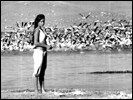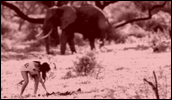Africa Story
- Year
- 1981
- Original title
- Afurika Monogatari
- Japanese title
- アフリカ物語
- Alternative title
- A Tale of Africa
- The Green Horizon
- Director
- Cast
- Running time
- 120 minutes
- Published
- 24 June 2002



by Jasper Sharp
One of the more inventive directors of the Japanese New Wave of the 60s, Susumu Hani might have done well to adhere to that old show-business adage, "Never work with children or animals". It's true, his treatments on the former, with which he started his filmmaking career with such award winning documentaries as Children in the Classroom (Kyoshitsu no Kodomotachi, 1954) and Children Who Draw Pictures (E o Kaku Kodomotachi, 1956), culminating in his pièce de résistance of social criticism Nanami, First Love (Hatsukoi Jigokuhen, 1968) certainly proved that Hani had a deft hand when it came to coaxing refreshingly naturalistic performances out of casts of young non-professionals. However, with this overly precious would-be epic the director seems to be so cowed by his subject, the raw beauty of the Kenyan savannah and its denizens, that the end result resembles little more than a protracted holiday slide-show display, wasting its star lead (yes, that's THE Jimmy Stewart of It's a Wonderful Life and Rear Window) in a story that is almost completely shoe-horned out in favour of a deluge of shots of the country's wildlife.
As a tourist destination Kenya, indeed much of Africa, seems to have completely fallen off the map of late, losing ground to more backpacker-friendly locales such as Thailand or Vietnam. For a country whose largest industry is tourism, a couple of well-publicised traveller casualties and the fact that at least four of its neighbouring countries have suffered from lengthy and bloody civil wars in recent years (not to mention that two of these, Somalia and Sudan, enjoy prominent positions on the "anti-terrorist" hitlist) have decimated Kenya's economy over the past decade.
However, as one of the continent's most politically stable countries, over the years it has proved a rich source of inspiration for novelists and filmmakers alike, from the early colonial days when Hemingway penned, amongst other stories, The Snows of Kilimanjaro (a major hotel on the coast still proudly bares his name) up to the large screen incarnations of Joy Adamson's Born Free (James Hill, 1966) and Isak Dinesen's Out of Africa (Sydney Pollack, 1985). There's also, to name but two more, Harry Hook's powerful account of the Mau Mau uprisings in the 60s as seen through the eyes of The Kitchen Toto (1987) and Michael Radford's White Mischief (1988), a botched adaptation of James Fox's fascinating account of the real-life murder mystery set against the gin-sodden decadence of a handful of wealthy colonials during WW2, later more successfully rendered as a TV movie entitled The Happy Valley.
There's certainly a lot more tales to be squeezed from this fascinating country, though unfortunately virtually all of our recent representations of the African continent post-Live Aid seem to be through such Occidental projections as the endless reportages of war and famine that dominate our news channels - either to bolster the egos of fading rock stars or to aid the faltering election prospects of certain Western politicians (I recommend reading Somali author Nurrudin Farah for an African perspective on this, rather than for example, going to see Ridley Scott's Black Hawk Down) - or National Geographic-styled TV documentaries whose focus is more zoological than cultural or sociological.
Hani's film, made at a time when tourism to Kenya was at an all-time high, with the mass-influx of Italian and German resorts to such small coastal settlements as Malindi and Watamu (now near ghost-towns) and the erection of exclusive game-lodges for wealthy Japanese businessmen bringing an exotic safari-chic into vogue, is guilty of the latter crime and seems totally ambivalent to any potential for human drama that the mise en scène might have allowed, favouring instead endless shots of elephants, lions and whatever else is at hand.
It seems strange that Hani seems so content to dwell on such superficial trimmings, not only given his impressive track record in the 60s, but also that he'd previously been in Kenya to film The Song of Bwana Toshi (Bwana Toshi No Uta, 1965) shortly after the country had achieved independence from Britain. Bwana Toshi had dealt with the cross-cultural encounters of a Japanese geological engineer with the local community in which he is sent to work, and at least addressed such issues as expatriate-local relationships and the misunderstandings that arise due to the cross-purposes of the parties involved. In Africa Story there's barely a black face in sight.
There's no real indication of a Japanese perspective either within the minimal plot that sees English actor Philip Sayer (whose career seems to have peaked with the 1983 video nasty XTRO) crash-landing his plane in the middle of the Savannah and stumbling in search of food into the domicile of James Stewart's grizzly old recluse and his daughter Maya. Maya is obviously smitten by the new arrival, but tensions between him and the old man send Sayer scurrying away at dawn. In any measure, his absence has already been noted by the Nairobi cocktail set, who send out a search party in the form of elegant Eleanora Vallone, eager to return him to civilisation.
As far as the human characters go, it is Maya, played by a pretty young Chinese-American actress here billed solely as "Kathy" (in presumably her only film appearance) who gets the lion's share of the screen time, as the film makes numerous recourses to extended montages of her gazing beatifically at butterflies and wildebeest whilst daintily twirling flowers between her fingers, drifting across arid landscapes in skimpy white outfits against luscious backdrops of flamingos and big wild game, and frolicking with her pet chimp in the scrub. Twee as such scenes are (have I mentioned that godawful theme song yet?), her fresh-faced presence is a breath of fresh air amongst the endless procession of animals. Hani, who pretty much avoided the feature film-making after Nanami, First Love in favour of making TV wildlife programs for the NHK such as Dobutsu Kazoku ("Animal Family") obviously had a lot of stock footage to get rid of. Stork, hippopotami, elephants, cheetahs, chimpanzee, impalas - they're all there aplenty, though the passivity of the creatures involved leads one to the conclusion that most of the footage must have been shot at the local animal orphanage. Stewart's house is a veritable Noah's ark, with a mongoose or a bush baby nestling in every pot or bookcase, and baby rhinos and leopard cubs nonchalantly roaming in and out as if they owned the place.
Despite the presence of Shuji Terayama, legendary revolutionary poet/playwright of the 60s and oft-affiliate of the New Wave (he scripted Hani's Nanami, to name but one film) in the credits as responsible for the "Original Idea", Hani's film has seemingly no overarching context or purpose other than cosmetic, seeming merely content to parade its exotic array of flora and fauna with no attempt at realism and no real feeling for its setting or the natural habitat of its inhabitants. It looks lovely, sure, but for a whole two hours it rapidly becomes pretty tedious.
No doubt thanks to the casting of its rather well-known star, obviously not one to knock back an all-paid trip to Africa even if confronted with a lousy script, Africa Story did at one time receive a US release. The film under review here is the Japanese version, and is dubbed accordingly, though dialogue is so sparse as to make it hardly an issue. As it stands, the incongruous sight of James Stewart conversing with a Maasai tribesman in fluent Japanese does lend the film a certain curiosity value, though it still can't disguise the fact, that in any language, Africa Story is quite awful.